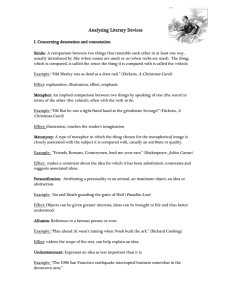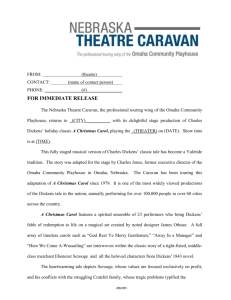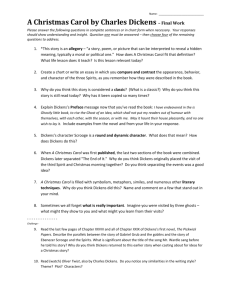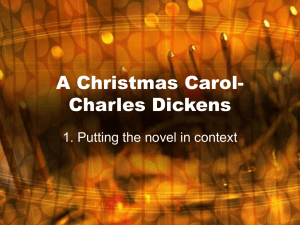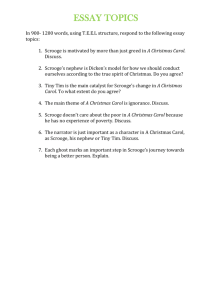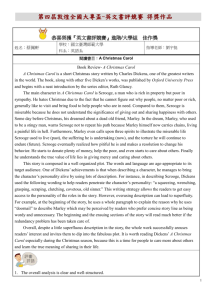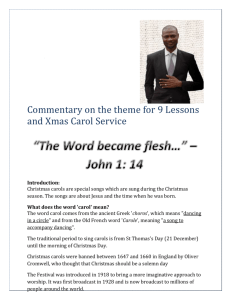TABLE OF CONTENTS - Milwaukee Repertory Theater
advertisement
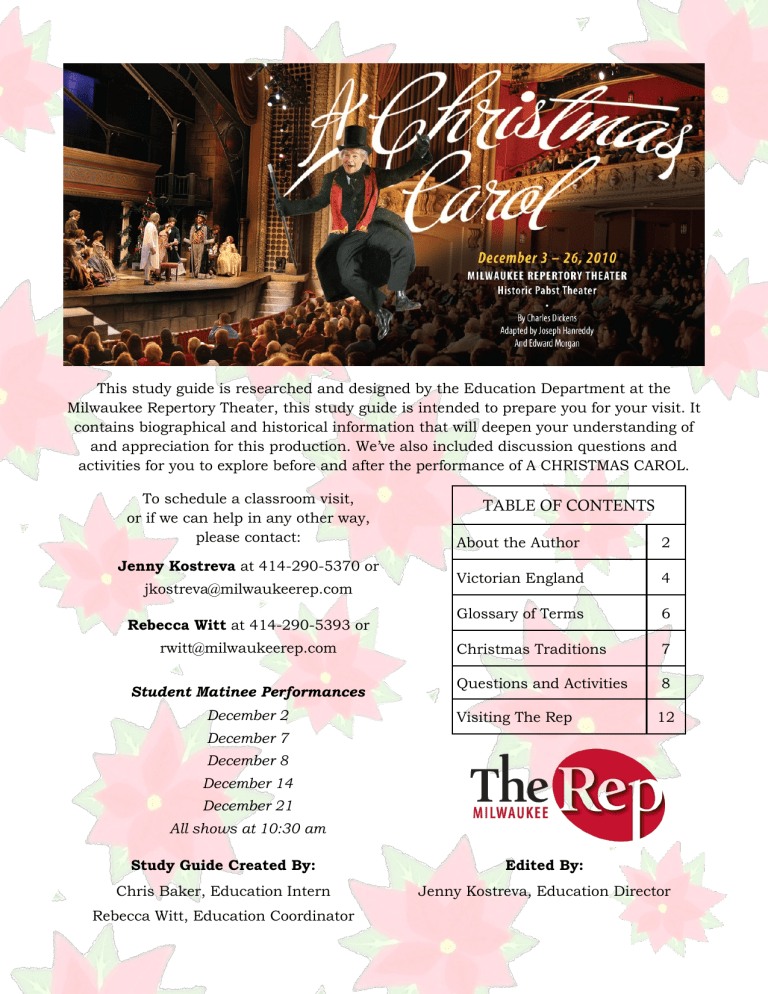
This study guide is researched and designed by the Education Department at the Milwaukee Repertory Theater, this study guide is intended to prepare you for your visit. It contains biographical and historical information that will deepen your understanding of and appreciation for this production. We’ve also included discussion questions and activities for you to explore before and after the performance of A CHRISTMAS CAROL. To schedule a classroom visit, or if we can help in any other way, please contact: Jenny Kostreva at 414-290-5370 or jkostreva@milwaukeerep.com Rebecca Witt at 414-290-5393 or rwitt@milwaukeerep.com Student Matinee Performances December 2 TABLE OF CONTENTS About the Author 2 Victorian England 4 Glossary of Terms 6 Christmas Traditions 7 Questions and Activities 8 Visiting The Rep 12 December 7 December 8 December 14 December 21 All shows at 10:30 am Study Guide Created By: Edited By: Chris Baker, Education Intern Jenny Kostreva, Education Director Rebecca Witt, Education Coordinator About the Author On the night before Charles Dickens was born, his affectionate but often impractical mother went dancing. Despite what must have been an unusual night, Charles Dickens was born without complication in Portsmouth, England on February 7, 1812. His father, John Dickens, worked as a clerk in the Navy Pay Office, which meant the family moved whenever and wherever the Navy demanded. At the age of five, the Dickens family moved to Chatham where they would remain for six years. During this time, Charles shared his parents’ home with five brothers and sisters. This was a period Charles would always refer to as “a time to be remembered like a happy dream through all our life after.” Charles was able to see the disgusting conditions in which the poor people of London were forced to live. Upon his father’s release from debtors’ prison, Charles went to school at Wellington Academy and, in 1827, became a clerk at a legal firm. Charles developed excellent shorthand skills at the legal firm and quickly landed a job at the Doctors’ Commons. This was where all the legal offices and courts were located. While Charles was reporting on what was happening in the courts, he learned of all the problems in the British legal system. Charles would use what he had seen and heard in the courts to criticize them in his later novels. Charles liked journalism, but he also enjoyed acting. It has been argued that the only Among the joys of this time was being cared reason Charles became a great novelist was for by a woman named Mary Weller who often because on the night of a big audition, he got read stories to the children. Charles suffered sick and was unable to perform. Only a year from seizures which often kept him from after this disappointing experience, in 1833, going outside to play, so he poured his energy Charles saw his first story published in into reading and acting. “Monthly Magazine.” The magazine immediately wanted more stories and Boz, Unfortunately, this period of happiness ended Dickens’ pen name, soon became known quite abruptly in 1823. Unable to pay his throughout England and the United States. debts, Charles’ father was arrested and taken to a debtors’ prison. With his father in jail, Charles married Catherine Hogarth in 1836, Charles could not go to school because he the same year he began his first novel The was expected to make money to feed his Pickwick Papers. This book, written originally family. Two days after his twelfth birthday, in segments for a magazine, would become a Charles was sent to work at a factory. The national favorite. Writing for a magazine was rest of Charles’ family, excluding him and his a way in which many people published books sister Fanny, went to live with his father at at this time. Chapters were printed in each the prison. Charles continued working and publication, so people would keep buying the living alone near the factory and Fanny magazine in order to finish the story. In fact, attended the Royal Academy of Music on many of Dickens’ successful novels, such as scholarship. Both went to visit their family Oliver Twist, Nicholas Nickelby, Great every Sunday. It was during this time that Expectations and A Tale of Two Cities, began A CHRISTMAS CAROL Study Guide Page 2 as magazine installments. Dickens had many fans in America, so in 1841 he and his wife decided to brave the Atlantic and take the long and dangerous journey to the United States. Dickens was not accustomed to the roughness of American society: for example, spittoons and chewing tobacco were unA copy of All the Year Round, featuring the first chapter of A known in England. He was especially Tale of Two Cities. horrified by slavery. The longer he spent in America, the more he wanted to go home. Soon after returning to England in 1843, Dickens began work on the first of five books he wanted published at Christmas. During his careful writing of A Christmas Carol, Dickens reported that he “wept and laughed and wept again.” The book was immediately popular, but Dickens received very little money due to poor contract arrangements. performances for charity in London. Dickens himself served as manager, producer and frequently as an actor. During this time, he realized what he had frequently referred to as his fondest daydream, “to settle down for the remainder of my life within easy distance of a great theater in which I should hold supreme authority.” In 1858, after separating from his wife, he began his own magazine called “All The Year Round” which featured weekly installments of his new book, A Tale of Two Cities. Following the book’s completion in 1860, Charles began work on Great Expectations. While writing, Dickens continued to do public readings of his works. They were very popular throughout London; unfortunately, they were also extremely draining. Five years later, in 1865, Dickens was involved in a train wreck. After the accident, he experienced dizzy spells, arthritis, gout and swelling of his left foot which further complicated his already failing health. On June 8, 1870, Dickens wrote all day, which was unusual for him. Normally, he would reserve only a few hours a day for writing. Later that night, he complained of a toothache and shortly thereafter fell out of his chair and lost consciousness. He was diagnosed with a brain aneurysm and died the following day. His body is buried in He followed up on the success of this holiday Westminster Abbey in Poets’ Corner. The book with another called The Chimes. He was words he spoke on the night of his last public eager to complete the book, claiming to have reading seem a fitting capstone to his remarkworked himself into a “regular ferocious able life: “From these garish lights, I now excitement” about it. Upon its completion, he vanish forevermore, with a heartfelt, grateful, reported, “I have had a good cry. I am worn to respectful, affectionate farewell.” death. I was obliged to lock myself in yesterday, for my face was swollen for the time to twice its proper size.” When Charles performed a reading of the book for a few close friends in 1844, a career of oral interpretation was born. Dickens performed public readings for charity and pleasure for most of the remainder of his life. Dickens’ career would soon take two more interesting turns. In 1848, Dickens organized an amateur theater company. During their ten years of operation, they gave over sixty Page 3 There have been many found variations of Charles Dickens’ signature; however, this signature is the most common and is figured to actually be the correct signature. A CHRISTMAS CAROL Study Guide Victorian England Victorian England was much different from the world we live in today. Living conditions were much worse and London provided few opportunities for the lower class to achieve success. Dickens often observed the city for days at a time in order to accurately reproduce the horrible state of affairs in his books. These thorough descriptions allow the reader to experience the sights, sounds and smells of the old city. Government Unlike the democracy that exists in America, England has a constitutional monarchy. Today, Queen Elizabeth II rules England. In Dickens’ day, Queen Victoria ruled the country. Under her direction, England gained control of India, Burma, New Zealand and Hong Kong, making England a very strong imperial power in the world. While Victoria did many good things to help improve her country, her main weakness was her willingness to let the rich become richer, while the poor continued work themselves to death. these days off so some unlucky souls had to come to work year round. In Dickens’ time, a typical clerk made about £80 (around $130) per year: just enough to rent a house and raise a family. In A CHRISTMAS CAROL, Scrooge pays his clerk Bob Cratchit “fifteen bob a week” or about £39 per year. Health “The Fever Patch” was the nickname for Victorian London due to overcrowding, pollution and poor public sanitation. The city was rampant with disease, including the most lifethreatening disease, cholera. It killed 140,000 Londoners during Dickens’ lifetime. Cholera is caused by impurities in drinking water, which half the city took from the Thames River, London’s central waterway. Unfortunately, it was also the main waste-disposal system where 200 open sewers ran into the Thames. The Thames was so disgusting that it created a stench so horrible it gave people headaches, made them nauseous and sometimes forced Parliament to take a break. The city’s health problems were Life was difficult for the compounded by the working class in ignorance of its Victorian London. medical professionals. Today, in the United At this time, doctors States a typical work believed that disease week is about 40 hours was spread through or five eight-hour days. It was not uncommon for children to work in tainted air rather than In Victorian London it factories during this era. Here, two young boys water. Throughout the was not unusual for work on a cotton gin. nineteenth century, it employees to work six was widely accepted twelve-hour days or 72 hours per week. Most that proper ventilation was the key to workers were given days off every Sunday, preventing disease. Hospitals were also of May Day and Christmas. However, businesses little help because they were few and far were not required to give their employees between and often times unaffordable as well Working Life A CHRISTMAS CAROL Study Guide Page 4 as unsafe. Due to crude surgical techniques and a flawed understanding about the nature of infection, the spread of hospitals led to an increase rather than a reduction in the death rate. According to mortality statistics, at this time it was actually safer to deliver your baby at home than in a hospital. had few restrictions on their behavior. Entire neighborhoods in London were demolished to make room for tracks, with no thought or aid given to the families who lived there. By the time laws were put in place to control the rail companies, over 76,000 people had been uprooted. Industry Education During the first half of the nineteenth century Education in the Victorian Era was a privilege Great Britain was adjusting to the effects of enjoyed by those who could afford it. In many the Industrial Revolution, when the cases money was so scarce that children from previously farming-based economy of the poor families were sent to work in factories as country changed to one relying more on soon as they were old enough. Whenever posindustry and manufacturing. Britain sible, these children would attend charity underwent a period of schools (ragged schools), swift urbanization, the where they were taught movement of large basic mathematics, populations from the reading and scripture. countryside to cities. Children from wealthy Scores of young men and families had more women were drawn to options. Young ladies London by the promise of were taught by a work and entertainment. governess, a woman who The rural poor were also taught in the family’s attracted to the city, home and sometimes seeking employment or lived there. Governesses at least a dry place to During the Victorian Era, industry was booming. taught the “delicate” sleep. Between 1800 and Factories were built all over in order to skills of dance, drawing, encourage urbanization. 1850 the population of music and French; London doubled, topping subjects generally at 2.3 million people. The city could not accepted as appropriate and necessary for support such a rapid increase in its populace, upper-class young women. Boys were and soon became massively overcrowded. typically sent to live in boarding schools, Says Kitson Clark, social historian, “Suitable where they were taught a more rounded housing did not exist, and the additional curriculum (reading, writing, history and numbers were crammed into every nook and mathematics). Boarding schools were harsh cranny from attic to cellar of old decaying places, where beatings were an accepted property… with little or no access to light and method of discipline, and dunce caps (coneair.” shaped hats which labeled the wearer a The creation of the steam railway made the “dunce” or idiot) were used to humiliate problem worse. The first steam locomotive students who didn’t learn fast enough. At was built in 1804 and rail transport proved so Eton, one of the most prestigious schools of profitable that the countryside was soon the time, boys were locked in their rooms crisscrossed with lines. Unfortunately, these from 8:00 pm until the next morning. railways were built by private companies who Page 5 A CHRISTMAS CAROL Study Guide Glossary of Terms Assign: One to whom the property and affairs of a deceased person are transferred. Counting House: An office in which a Bedlam: A London hospital for the insane bookkeeping, correspondence. Blindman’s Bluff: A popular English parlor game in which one person is blindfolded and must catch others. Fathom: A measurement of six feet used for calculating depths at sea or in mines. Brazier: An open pan used for holding coals. Carol: A joyous song or ballad; a song of praise Chaise: A two-wheeled vehicle with a folding top, drawn by a single horse. Charwoman: A woman, most typically hired by the day, to do housework. Coach-and-Six: A coach driven by six horses. Comforter: A scarf. Copper: A large pot used for washing or cooking. commercial company carries on Garret: A room or set of rooms in an attic. Gratis: Freely, without expense. Gruel: Broth or soup of oatmeal and chopped meat. Old Screw: Slang for “Miser”, hence possible the name “Scrooge.” Porter: A dark brown English beer. Repeater: A watch or clock fitted with a device that causes the repetition of the last hour struck. Scrooge: The character in A CHRISTMAS CAROL was based in part on the old gravedigger in “The Pickwick Papers.” Pence and Shillings, Pounds and Guineas: Victorian Currency Farthing ¼ of a Penny Copper Ha’penny ½ of a Penny Copper Pence Penny Silver Shilling 12 Pence (also known as a “Bob”) Silver Half-a-crown 2 ½ Shillings, or 30 Pence Silver Crown 5 Shillings, or 60 Pence Silver Pound (or notes) 20 Shillings, or 240 Pence Gold Guinea (or notes) 21 Shillings Gold A CHRISTMAS CAROL Study Guide Page 6 Christmas Traditions Christmas in Victorian England shared only a few similarities with the way it is currently celebrated in homes that recognize the holiday. During this time, traditions were being joined by newer methods of celebrating that many people still enjoy today. BEFORE 1840 January 6th, for a long time, was celebrated as “Twelfth Night.” In Christianity, this night was the supposed night that the wise men arrived in Bethlehem. The celebration usually included a twelfth cake, similar to pound cake, which often had a lucky bean or coin baked inside. A long time non-religious tradition of singing door to door throughout the entire year gave birth to what we now know as caroling, which is done specifically during the holiday season. Its origins date back to the middle ages when peasants would offer a song in exchange for food and drink. AFTER 1840 The very first Christmas Cards were printed in England in 1843. However, it would not be until the early 1900’s that they were a regular part of holiday celebrations. Santa Claus arose from the stories of St. Nicholas, a saint admired by Dutch immigrants. The image we recognize today was actually made popular by author Clement Clarke Moore who wrote The Night Before Christmas in 1822. However, Santa Claus did not become accepted in England until the 1870’s. The Christmas tree had been prevalent in Germany even before the 1800’s. It did not become popular in England until after Queen Victoria married a German man who wished to include the Yuletide tree in the royal celebrations. After the 1850’s, English families who could afford a tree would have one. In Ancient times, mistletoe, holly and ivy were associated with pagan midwinter celebrations. Georgina McKee, Jonathon However, by the time A Smoots, Joetta Wright and Mariel Neto in The Rep’s Christmas Carol was writ2009 production. Photo ten, these greens were accourtesy of Jay Westhauser cepted decorations in ChrisThe candy cane was originated tian homes as well. Mistlein the 1600s to look like a Sheppard's toe, or the kissing bow, was usually the crook and then was given to children in centerpiece of a room’s decorations. church to keep them quiet. People started to use the candy cane as an Gift giving originated in the middle ages; ornament for trees during the however, gifts were only a very small mid-1800’s because they were sturdy part of most celebrations. Wealthy and colorful. Eventually, they became a families might exchange a few simple Christmas treat. gifts, but poor families usually did not. Page 7 A CHRISTMAS CAROL Study Guide Questions and Activities A CHRISTMAS CAROL takes place in Victorian England. Societal and economic conditions of the time a great influence on people, their attitudes towards class, money and values. Compare Victorian England to American society today. What are the similarities and differences? What are some examples of how we are still preoccupied with money and material objects? Do you think these attitudes need to change? Why or why not? future. What would you want to see? Why? Imagine that you work for Scrooge before his transformation. How would you handle a person like this? Would you be mean or would you try to be nice to that person? What would your actions say about you as a person? If you had to choose only one among the many he made, what do you think is Scrooge’s biggest mistake? Why? Dickens did not have the modern conveniences that Scrooge is visited by the we have today: electricity, Ghosts of Christmas Past, telephones, computers, or Present and Future. These kitchen appliances, among three figures help Scrooge other things. Think about go through a major what it would be like to not Scrooge, played by Resident Acting transformation. Think Company Member James Pickering, have any of these about a time in your life during The Rep’s 2009 A CHRISTconveniences. What MAS CAROL production. Photo when someone helped you difficulties might you have? courtesy Jay Westhauser. change your behaviors. How would you have to How did you feel about this adapt in order to live without them? For person at the time? How did you change? half a day turn off the lights, take the What did you learn about yourself? phone off the hook, shut down all the Each of the Ghosts that visit Scrooge computers and have a full class without behave and look different? Which one had any electricity. Was it difficult to go the most profound effect on Scrooge? through half a day without any of these conveniences? Why? What do you think it Why? would be like to never have any of these During the play, we meet two young things? children named Want and Ignorance. What do you think Dickens was trying to Scrooge is given the chance to see his show us about ourselves by including past, present and future. Imagine you these children? were given an opportunity to see the A CHRISTMAS CAROL Study Guide Page 8 Victorian England Crossword C T S N I A R T A V A C L H A M S T E A M I C H D P O A P B Q X K C V A J C S L T I A C H T Y R K P V Y E T T O S O U I U A H C F R H P R R S T E R F R H W A E H I T Y S L B A U S M C M A V S E I A F C F E N S U I C T A U L M T S U E Q Z H O M R E T B O D R I L O N E N V H L A R A U T O B N U W L I C Q Y P R O A T K J F M K W B B A L R A I L C O M P A N Y S S K W P J U T S R U N P U S M O N A R C H Y T D VICTORIA TRAINS CHOLERA RAIL COMPANY ETON PARLIAMENT STEAM MONARCHY FACTORY DUNCE THAMES CHARITY SCHOOLS The Rep’s cast of the 2009 A CHRISTMAS CAROL production. Photo courtesy of Jay Westhauser. Page 9 A CHRISTMAS CAROL Study Guide Questions and Activities Continued Color is important when trying to create a certain mood. Draw a picture of your favorite scene in A CHRISTMAS CAROL. Be sure to use appropriate colors to show the mood of the scene. what country you live in and what religion you practice. For example, in France Christmas is called Noel. Different religions celebrate Ramadan, Kwanza or Hannukah. In small groups, pick a country or religion and research how they celebrate their holidays. Share what you have found with the rest of your class. Consider the set, props, costumes and Nell Geisslinger, Gerard Neugent and music for A CHRISTJames Pickering in The Rep’s 2009 MAS CAROL. How do production of A CHRISTMAS CAROL. Photo courtesy of Jay Westhauser. each of these things help tell the story? There are many Christmas traditions Which elements did you find most effective? Would you have done anything and celebrations that are seen in A CHRISTMAS CAROL: Fezziwig’s party, the differently? How so? gathering at Fred’s and the Cratchit Scrooge was able to turn his ways family dinner. What winter traditions does around and help out someone less your family have? Have you started any fortunate than him. With your class, do new traditions? Write briefly about a something for the less fortunate this special tradition or celebration that you Christmas-- have a food drive, buy gifts or enjoy. donate coats and blankets to shelters. Invite other classes, friends and family members to help make a difference in the lives of others. A Christmas Carol was originally written in 1843 and had been adapted into many plays, movies, books and more and The Rep has been doing A CHRISTMAS CAROL since 1975 (35 years!!). Why do you think this story stands the test of time. Why is this story an important one to tell? Winter holidays are celebrated differently all over the world depending on A CHRISTMAS CAROL Study Guide The cast of A CHRISTMAS CAROL in the 2009 production. Photo courtesy of Jay Westhauser Page 10 Answer Key for Crossword C T S N I A R T A V A C L H A M S T E A M I C H D P O A P B Q X K C V A J C S L T I A C H T Y R K P V Y E T T O S O U I U A H C F R H P R R S T E R F R H W A E H I T Y S L B A U S M C M A V S E I A F C F E N S U I C T A U L M T S U E Q Z H O M R E T B O D R I L O N E N V H L A R A U T O B N U W L I C Q Y P R O A T K J F M K W B B A L R A I L C O M P A N Y S S K W P J U T S R U N P U S M O N A R C H Y T D Resources and Further Reading Ackroyd, Peter. Dickens’ London: An Imaginative Vision. London: Pilot Productions, 1987. Jackson, Lee. Dictionary of Victorian London. 1 October 2009. 8 October 2008. <http://www.victorianlondon.org>. McKellar, Shona. Eyewitness Classics: A Christmas Carol. New York: DK Publishing, 1997. Perdue, David. Charles Dickens Page. 8 October 2008. 9 October 2009. <http://charlesdickenspage.com/>. McIlvain, John. Charles Dickens - A Christmas Carol: A Study Guide with Consideration for Grammar. 15 October 2009. <http:// www.leasttern.com/ChristmasCarol/ CCarol.html>. Sammon, Paul. The Christmas Carol Trivia Book. New York: Citadel Press, 1994. Page 11 A CHRISTMAS CAROL Study Guide Visiting The Rep The Milwaukee Repertory Theater is housed downtown in the Milwaukee Center at the corner of Wells and Water Streets. Our building was formerly the home of Electric Railway & Light Company. This name is still carved on the wall outside. You’ll enter on the Wells Street side into a large, open space. Our box office will be visible on your left as you come through the front doors. The large space is the main hub for the businesses that share this building: a bank, an office tower, the Pabst Theater and the Intercontinental Hotel. Our production of A CHRISTMAS CAROL will be held in the Pabst Theater. If you enter from the Wells Street side of the building, the box office of the Pabst Theater will be immediately to your right. The entrance to the theater is next to the Pabst box office or through the doors on Wells Street. School groups should follow the directions mailed to you. For student matinees, a staff member will great your bus upon arrival. Inside the lobby are restrooms, water fountains and a coat check. If you decide to bring a snack, please know that food and drink are NOT permitted in the theater. However, you can leave things (at your own risk) in the coat check room, and enjoy them outside the theater during the intermission. A CHRISTMAS CAROL typically runs two hours with an intermission. You might also want to look for signs in the lobby which give the specific “running time” of the play. FOR INFORMATION ON OUR EDUCATION PROGRAMS AND OUR PRODUCTIONS, VISIT OUR WEBSITE AT WWW.MILWAUKEEREP.COM PROGRAMS IN THE EDUCATION DEPARTMENT RECEIVE GENEROUS FUNDING FROM: THE EINHORN FAMILY FOUNDATION GE HEALTHCARE THE HARLEY-DAVIDSON FOUNDATION THE RICHARD AND ETHEL HERZFELD FOUNDATION JOHNSON CONTROLS MPS PARTNERSHIP FOR THE ARTS MPS PARTNERSHIP FOR THE HUMANITIES NORTHWESTERN MUTUAL FOUNDATION PNC BANK TARGET WE ENERGIES “YOU NEED THREE THINGS IN THE THEATRE – THE PLAY, THE ACTORS AND THE AUDIENCE, AND EACH MUST GIVE SOMETHING.” – KENNETH HAIGH Theater is described as a collaborative art form. The success of a production relies upon every member of the process: playwrights, directors, designers, technicians, actors and the audience. Plays require audiences to give a new life to performances through their careful attention and enthusiastic reactions. The audience has an active role to play and the actors rely on you to be respectful and attentive. Through your observation of sets, costumes, lighting and the work of the actors, you’ll be better able to follow the story and enjoy the live presentation. You are important in the final performance and your participation is what makes this process worthwhile. MILWAUKEE REPERTORY THEATER DEPARTMENT OF EDUCATION http://www.milwaukeerep.com/education/outreach.htm Jenny Kostreva, Education Director jkostreva@milwaukeerep.com 414-290-5370 Rebecca Witt, Education Coordinator rwitt@milwaukeerep.com 414-290-5393
